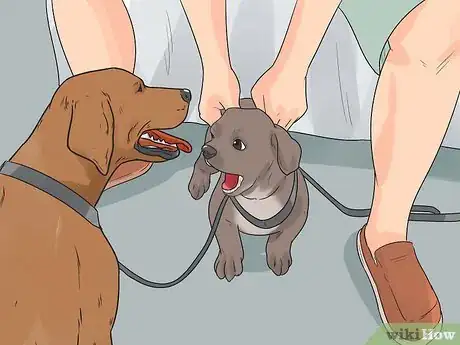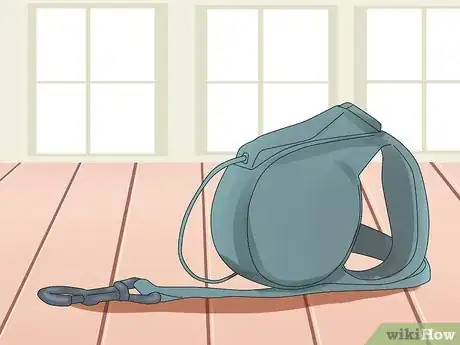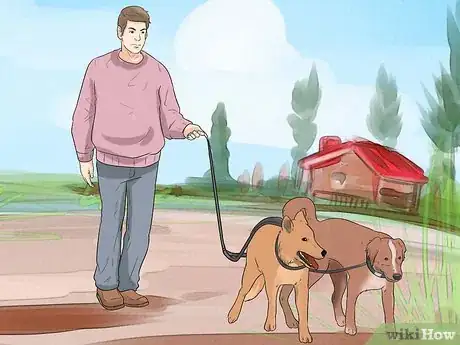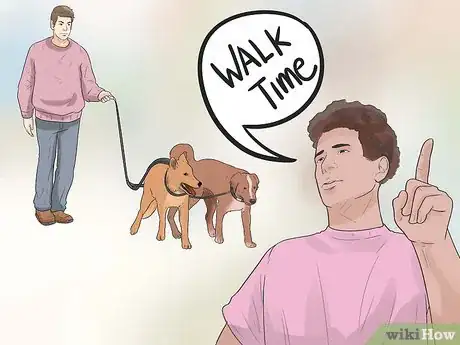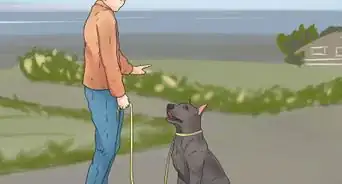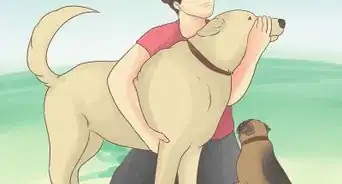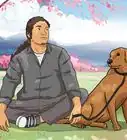This article was co-authored by David Levin. David Levin is the Owner of Citizen Hound, a professional dog walking business based in the San Francisco Bay Area. With over 9 years of professional dog walking and training experience, David's business has been voted the "Best Dog Walker SF" by Beast of the Bay for 2019, 2018, and 2017. Citizen Hound has also been ranked #1 Dog Walker by the SF Examiner and A-List in 2017, 2016, 2015. Citizen Hound prides themselves on their customer service, care, skill, and reputation.
There are 7 references cited in this article, which can be found at the bottom of the page.
This article has been viewed 98,528 times.
Walking your doggie is a fun way to bond with and provide exercise for them. But what if you have two dogs? Walking your two dogs with two leashes can lead to tangled knots and confusion. Instead, try walking both dogs on one leash. You’ll soon see that walking two dogs on one leash gives you twice the opportunity for fun!
Steps
Planning to Walk Your Dogs
-
1Choose the dogs you want to walk together. The dogs you want to walk together on one leash should know each other already. If their temperaments are not compatible, they may fight each other or get into trouble. Only walk dogs who are relaxed when together and leash trained.[1] Dogs who do not stop when commanded to do so, or come when beckoned, should not be brought on walks with another dog.
-
2Attach the two dogs to one leash. You can buy double walker leashes which branch out at the end, allowing two dogs to be attached. Alternately, you could employ a coupler. A coupler is a small V-shaped leash extender which allows your leash to accommodate two dogs instead of one.[2] It will save you money that you’d otherwise have to spend on an entirely new leash. Couplers and double walker leashes are equally good options for the individual looking to walk two dogs on one leash.
- Attach each dog, one at a time, to one side of the V-shaped branch. You can place your dogs on either side of the leash coupler.
- Whether you buy a coupler or a double walker leash, ensure it possesses appropriate level of tensile strength and will not break.
Advertisement -
3Choose the right leash. A thin, lightweight leash is best for a smaller dog. A larger dog, by contrast, requires a more heavy-duty leash with a strong clip. The clip must be strong enough not to break under pressure when pulled against the metal ring on the dog’s collar.[3] If the leash clip breaks, your dogs might run off.
- The basic leash is 6 feet long and is the standard leash with which people walk their dogs.
- A retractable leash consists of a spring-loaded device within a a plastic case. When the dog runs out, the leash will, with slight resistance, extend in length (up to its limit). If you wish to keep the dog nearby, you can lock the leash so that the length does not extend at all. Be careful with these because a dog who takes off at a full run might be able to break the leash. The handle might be uncomfortable in your hands as well. Try one or several retractable leashes out before buying.
- A bungee leash stretches and retracts. Made of rubber or elastic, bungee leashes are good for doggies who vigorously pull on their leashes.
- Long line leashes are extra long for dogs who like to roam and explore. They vary in length from 10 to 60 feet. Be careful with these leashes; dogs who run too far afield might end up in traffic or encounter other dangers.
- Avoid extending leashes if your dogs like to pull. These have a tendency to teach and enable pulling.
-
4Select the right collar for your doggie.[4] When picking a collar, choose a color which contrasts with his fur. For instance, do not get a brown collar for a brown dog. You’ll want people to see that he has a collar in case he or she runs off while unleashed. Pick a collar which accommodates the width of your dog’s neck. Collars should be adjusted so as to allow you to slip one finger between the collar and your dog’s neck. There are many varieties of collars available.
- A standard flat collar is usually made of nylon or leather. You can purchase these at most stores. Some dogs whose necks are larger than their heads -- such as Greyhounds and Whippets -- might slip out of them.
- Martingale collars are ideal for larger dogs like Greyhounds. These collars are looped around a dog’s neck just as normal collars are, but will tighten as a dog pulls away. In this way, dogs are unable to escape or remove the collar on their own.
- Front-clip harness collar are similar to back-clip harness collars, but with the difference that the clip to which the leash attaches is located in the front of the harness, not on the back. These harness collars give you more control over the dog than a back-clip harness.
- Head collars consist of one clip for the neck and one for the muzzle. Along with front-clip harnesses, head collars are favored by dog owners because they allow you to lead the dog in whatever direction you want, rather than pulling on its neck.
- If you want your dogs to walk side-by side, try the short chain method. The short chain method involves clipping the two dogs’ collars together with a chain link so they are closer together. This will get them used to walking near each other. Later, extend the chain to full length.
Walking Your Dogs Together
-
1Begin walking your dogs together in a low-distraction area.[5] Your dogs are liable to forget their manners while walking alongside each other. They might become rambunctious in the presence of a canine companion, and forget all their training.[6] The potential for misbehavior is compounded when there are other distractions about.
- Do not walk your dogs on one leash around a public park or area where they are liable to encounter other dogs or other novel fauna. Walk your dogs instead, at first, around a quiet, relatively deserted space such as a woodland path or suburban neighborhood. Your back yard is also a good place to start practicing.
-
2Put a stop to any misbehavior.[7] Dogs who misbehave can lead other dogs to do the same. For instance, if you’re walking a dog who lunges or barks at passers-by, your other dog might pick up the bad behavior.
- Walk each dog separately before walking them together. This will ensure each dog is already familiar with your expectations and commands when being walked, and prevent potential misbehavior.
- Be consistent when punishing or correcting misbehavior. Inconsistencies will confuse your dog and make training more difficult.[8]
-
3Monitor your dogs’ behavior closely. Only allow your dogs to walk forward when there is some slack in the leash.[9] This “loose-leash training” will prevent pulling, which can restrict your dog’s breathing. Also, look for signs of aggression or tension in your dogs, such as an arched back, growling, biting (not friendly nipping), and bared teeth. Remove one or the other of the two dogs if either starts showing signs of aggression.
-
4Walk your dogs on one leash together regularly.[10] Dogs which walk together on one leash can experience increased companionship and opportunity for socialization with one another. Let them get excited about going on walks together by announcing, for instance, “Walk time!” right before you attach their collars to the leash. Give them time to get used to walking together. Walk your dogs together regularly on one leash to afford them continued opportunities for mutual enjoyment.
Community Q&A
-
QuestionHow do you walk two dogs without pulling?
 David LevinDavid Levin is the Owner of Citizen Hound, a professional dog walking business based in the San Francisco Bay Area. With over 9 years of professional dog walking and training experience, David's business has been voted the "Best Dog Walker SF" by Beast of the Bay for 2019, 2018, and 2017. Citizen Hound has also been ranked #1 Dog Walker by the SF Examiner and A-List in 2017, 2016, 2015. Citizen Hound prides themselves on their customer service, care, skill, and reputation.
David LevinDavid Levin is the Owner of Citizen Hound, a professional dog walking business based in the San Francisco Bay Area. With over 9 years of professional dog walking and training experience, David's business has been voted the "Best Dog Walker SF" by Beast of the Bay for 2019, 2018, and 2017. Citizen Hound has also been ranked #1 Dog Walker by the SF Examiner and A-List in 2017, 2016, 2015. Citizen Hound prides themselves on their customer service, care, skill, and reputation.
Professional Dog Walker Back-clip harness collars fit over the dog’s chest and attach to the leash by a clip on the dog’s back. These work best for small dogs since regular collars can hurt their necks if they pull.
Back-clip harness collars fit over the dog’s chest and attach to the leash by a clip on the dog’s back. These work best for small dogs since regular collars can hurt their necks if they pull. -
QuestionWhat's the easiest way to walk multiple dogs at the same time?
 David LevinDavid Levin is the Owner of Citizen Hound, a professional dog walking business based in the San Francisco Bay Area. With over 9 years of professional dog walking and training experience, David's business has been voted the "Best Dog Walker SF" by Beast of the Bay for 2019, 2018, and 2017. Citizen Hound has also been ranked #1 Dog Walker by the SF Examiner and A-List in 2017, 2016, 2015. Citizen Hound prides themselves on their customer service, care, skill, and reputation.
David LevinDavid Levin is the Owner of Citizen Hound, a professional dog walking business based in the San Francisco Bay Area. With over 9 years of professional dog walking and training experience, David's business has been voted the "Best Dog Walker SF" by Beast of the Bay for 2019, 2018, and 2017. Citizen Hound has also been ranked #1 Dog Walker by the SF Examiner and A-List in 2017, 2016, 2015. Citizen Hound prides themselves on their customer service, care, skill, and reputation.
Professional Dog Walker Get a leash splitter that has multiple leads attached to one handle. That way, you can control all of the dogs at the same time while you're walking them.
Get a leash splitter that has multiple leads attached to one handle. That way, you can control all of the dogs at the same time while you're walking them. -
QuestionWith small dogs, is it better to have a shorter extender for the one leash, or is it better for a longer extender?
 Community AnswerEither will work. It is most important for you to keep the same length for both dogs.
Community AnswerEither will work. It is most important for you to keep the same length for both dogs.
Warnings
- If using the short chain method to bind two dogs’ collars together, do not use a choke or martingale collar on either dog. If one dog moves away, the other dog will be hurt.⧼thumbs_response⧽
References
- ↑ http://www.vetstreet.com/our-pet-experts/how-do-i-walk-two-dogs-at-once
- ↑ David Levin. Professional Dog Walker & Trainer. Expert Interview. 19 December 2019.
- ↑ http://www.humanesociety.org/animals/dogs/tips/leashes.html?referrer=https://www.google.com/
- ↑ http://www.akc.org/learn/akc-training/best-collars-leashes-for-dogs/
- ↑ http://www.vetstreet.com/our-pet-experts/how-do-i-walk-two-dogs-at-once?page=2
- ↑ David Levin. Professional Dog Walker & Trainer. Expert Interview. 19 December 2019.
- ↑ http://www.vetstreet.com/our-pet-experts/how-do-i-walk-two-dogs-at-once
- ↑ David Levin. Professional Dog Walker & Trainer. Expert Interview. 19 December 2019.
- ↑ http://www.vetstreet.com/our-pet-experts/how-do-i-walk-two-dogs-at-once?page=2
About This Article
To walk two dogs with one leash, try to take them to a quiet area with few distractions, like a woodland path or suburban neighborhood, so they don't get excited and act out. You should also put a stop to any misbehavior, such as barking or lunging at people, since one dog might copy the other one if it's misbehaving. Try to be consistent when punishing misbehavior to avoid confusing the dogs. Additionally, be patient with them, since it can take time for dogs to get used to being walked together. For more tips from our Veterinary co-author, including how to choose a double walker leash or coupler for walking two dogs at once, read on!

